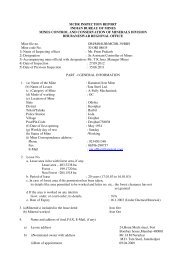Market Survey on Copper - Indian Bureau of Mines
Market Survey on Copper - Indian Bureau of Mines
Market Survey on Copper - Indian Bureau of Mines
You also want an ePaper? Increase the reach of your titles
YUMPU automatically turns print PDFs into web optimized ePapers that Google loves.
ii) Manganese br<strong>on</strong>ze (high strength brass) and leaded manganese br<strong>on</strong>ze<br />
(High tensile brass)<br />
iii) <strong>Copper</strong>-zinc-silic<strong>on</strong> alloys (Silic<strong>on</strong> brass and br<strong>on</strong>ze) and<br />
iv) Cast <strong>Copper</strong>-bismuth & <strong>Copper</strong>-bismuth-selenium alloys<br />
IV) Br<strong>on</strong>zes- The term br<strong>on</strong>ze originally describe alloys with tin as the <strong>on</strong>ly<br />
principal alloying element. The wrought br<strong>on</strong>ze alloys include (a) <strong>Copper</strong>-Tin-<br />
Phosphorus alloy (Phosphor br<strong>on</strong>zes) (b) <strong>Copper</strong>-tin-lead-phosphorus alloys<br />
(leaded phosphor br<strong>on</strong>zes) (c) <strong>Copper</strong>-aluminium alloys (aluminium br<strong>on</strong>zes)<br />
and (d) <strong>Copper</strong>-silic<strong>on</strong> alloys (silic<strong>on</strong> br<strong>on</strong>zes). The cast br<strong>on</strong>ze alloys<br />
include (a) <strong>Copper</strong>-tin-alloys (Tin br<strong>on</strong>zes) (b) <strong>Copper</strong>-tin-lead alloys (leaded<br />
& high leaded tin br<strong>on</strong>zes) (c) <strong>Copper</strong>-tin-nickel alloys (Nickel-tin br<strong>on</strong>zes)<br />
and (d) <strong>Copper</strong>- aluminium alloys (aluminium br<strong>on</strong>zes).<br />
There are some more alloys made <strong>of</strong> copper namely copper-nickel alloys,<br />
copper-nickel-zinc alloys or ‘nickel silver’, leaded copper-20% or more lead, etc.<br />
2.2 CLASSIFICATION AND GRADES<br />
2.2.1 American Standard<br />
<strong>Copper</strong> is classified according to the method by which it is refined, and<br />
is specified as fire-refined copper, electrolytic copper and chemically refined<br />
copper. Fire refined copper is produced from crude copper by<br />
pyrometallurgical process.<br />
Some grades <strong>of</strong> fire-refined copper can be used as electrical c<strong>on</strong>ductor,<br />
but most are used for alloying. Most electrolytic copper is produced by<br />
electrolytic anode-to-cathode transfer <strong>of</strong> metal through a copper sulphate<br />
soluti<strong>on</strong>.<br />
Cathode copper has become the single most important commercial form<br />
<strong>of</strong> copper and it accounts for nearly three-fourth <strong>of</strong> the refined copper c<strong>on</strong>sumed<br />
annually.<br />
A c<strong>on</strong>siderable quantity <strong>of</strong> refined copper is settled and cast into various<br />
refinery shapes for c<strong>on</strong>sumer use. Commercially, this type <strong>of</strong> copper is<br />
classified by the method <strong>of</strong> processing. During melting and casting <strong>of</strong> final<br />
shapes, the amount <strong>of</strong> oxygen absorbed has a critical influence <strong>on</strong> the<br />
properties <strong>of</strong> the metal. Accordingly, apart from cathode, there are three basic<br />
classes <strong>of</strong> commercial copper.<br />
(a) Tough-pitch copper, which is electrolytic or fire-refined copper cast in<br />
refinery shapes and c<strong>on</strong>taining 0.02 to 0.05 per cent oxygen as cuprous oxide.<br />
(b) Oxygen-free copper, which is refined copper under deoxidising<br />
atmosphere.<br />
(c) De-oxidised copper, which is refined copper free from cuprous oxide<br />
through the use <strong>of</strong> deoxidisers<br />
The details <strong>of</strong> classificati<strong>on</strong> are given in Table: 2.2.<br />
12
















